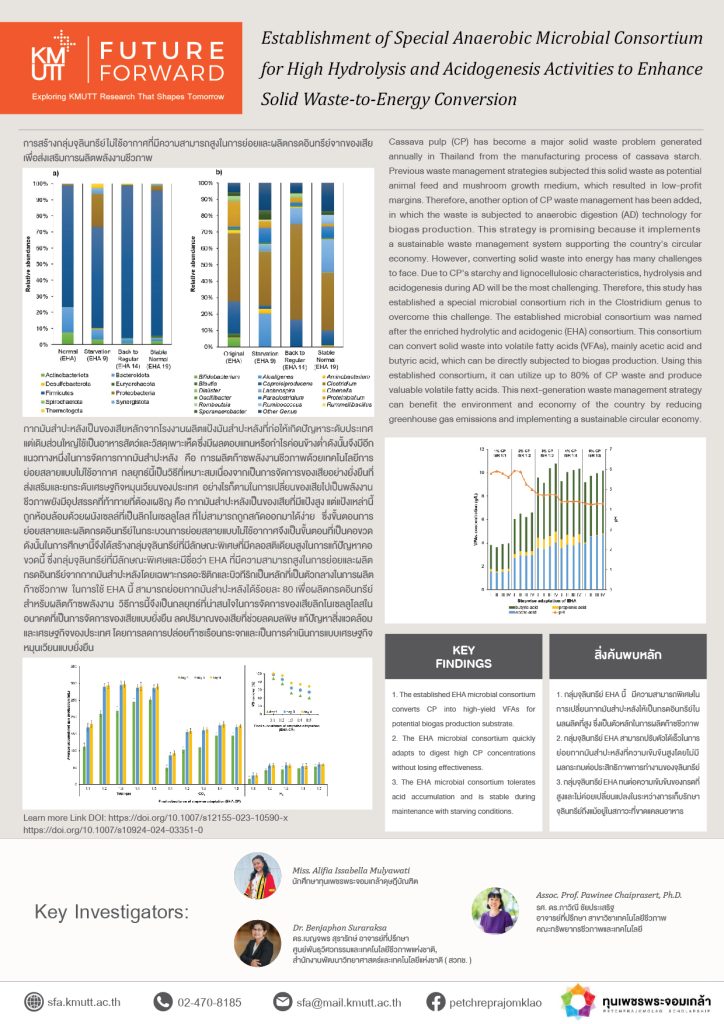Cassava pulp (CP) has become a major solid waste problem generated annually in Thailand from the manufacturing process of cassava starch. Previous waste management strategies subjected this solid waste as potential animal feed and mushroom growth medium, which resulted in low-profit margins. Therefore, another option of CP waste management has been added, in which the waste is subjected to anaerobic digestion (AD) technology for biogas production. This strategy is promising because it implements a sustainable waste management system supporting the country’s circular economy. However, converting solid waste into energy has many challenges to face. Due to CP’s starchy and lignocellulosic characteristics, hydrolysis and acidogenesis during AD will be the most challenging. Therefore, this study has established a special microbial consortium rich in the Clostridium genus to overcome this challenge. The established microbial consortium was named after the enriched hydrolytic and acidogenic (EHA) consortium. This consortium can convert solid waste into volatile fatty acids (VFAs), mainly acetic acid and butyric acid, which can be directly subjected to biogas production. Using this established consortium, it can utilize up to 80% of CP waste and produce valuable volatile fatty acids. This next-generation waste management strategy can benefit the environment and economy of the country by reducing greenhouse gas emissions and implementing a sustainable circular economy.
![]()
![]() การสร้างกลุ่มจุลินทรีย์ไม่ใช้อากาศที่มีความสามารถสูงในการย่อยและผลิตกรดอินทรีย์จากของเสียเพื่อส่งเสริมการผลิตพลังงานชีวภาพ
การสร้างกลุ่มจุลินทรีย์ไม่ใช้อากาศที่มีความสามารถสูงในการย่อยและผลิตกรดอินทรีย์จากของเสียเพื่อส่งเสริมการผลิตพลังงานชีวภาพ![]()
![]()
กากมันสำปะหลังเป็นของเสียหลักจากโรงงานผลิตแป้งมันสำปะหลังที่ก่อให้เกิดปัญหาระดับประเทศ แต่เดิมส่วนใหญ่ใช้เป็นอาหารสัตว์และวัสดุเพาะเห็ด ซึ่งมีผลตอบแทนหรือกำไรค่อนข้างต่ำ ดังนั้นจึงมีอีกแนวทางหนึ่งในการจัดการกากมันสำปะหลัง คือ การผลิตก๊าซพลังงานชีวภาพด้วยเทคโนโลยีการย่อยสลายแบบไม่ใช้อากาศ กลยุทธ์นี้เป็นวิธีที่เหมาะสมเนื่องจากเป็นการจัดการของเสียอย่างยั่งยืนที่ส่งเสริมและยกระดับเศรษฐกิจหมุนเวียนของประเทศ อย่างไรก็ตามในการเปลี่ยนของเสียไปเป็นพลังงานชีวภาพยังมีอุปสรรคที่ท้าทายที่ต้องเผชิญ คือ กากมันสำปะหลังเป็นของเสียที่มีแป้งสูง แต่แป้งเหล่านี้ถูกห้อมล้อมด้วยผนังเซลล์ที่เป็นลิกโนเซลลูโลส ที่ไม่สามารถถูกสกัดออกมาได้ง่าย ซึ่งขั้นตอนการ
ย่อยสลายและผลิตกรดอินทรีย์ในกระบวนการย่อยสลายแบบไม่ใช้อากาศจึงเป็นขั้นตอนที่เป็นคอขวด ดังนั้นในการศึกษานี้จึงได้สร้างกลุ่มจุลินทรีย์ที่มีลักษณะพิเศษที่มีคลอสติเดียมสูงในการแก้ปัญหาคอขวดนี้ ซึ่งกลุ่มจุลินทรีย์ที่มีลักษณะพิเศษและมีชื่อว่า EHA ที่มีความสามารถสูงในการย่อยและผลิตกรดอินทรีย์จากกากมันสำปะหลัง โดยเฉพาะกรดอะซิติกและบิวทีริกเป็นหลักที่เป็นตัวกลางในการผลิตก๊าซชีวภาพ ในการใช้ EHA นี้ สามารถย่อยกากมันสำปะหลังได้ร้อยละ 80 เพื่อผลิตกรดอินทรีย์สำหรับผลิตก๊าซพลังงาน วิธีการนี้จึงเป็นกลยุทธ์ที่น่าสนใจในการจัดการของเสียลิกโนเซลลูโลสในอนาคตที่เป็นการจัดการของเสียแบบยั่งยืน ลดปริมาณของเสียที่ช่วยลดมลพิษ แก้ปัญหาสิ่งแวดล้อม และเศรษฐกิจของประเทศ โดยการลดการปล่อยก๊าซเรือนกระจกและเป็นการดำเนินการแบบเศรษฐกิจหมุนเวียนแบบยั่งยืน
![]() 𝗞𝗘𝗬 𝗙𝗜𝗡𝗗𝗜𝗡𝗚𝗦
𝗞𝗘𝗬 𝗙𝗜𝗡𝗗𝗜𝗡𝗚𝗦![]()
1. The established EHA microbial consortium converts CP into high-yield VFAs for potential biogas production substrate.
2. The EHA microbial consortium quickly adapts to digest high CP concentrations without losing effectiveness.
3. The EHA microbial consortium tolerates acid accumulation and is stable during maintenance with starving conditions.
❯❯ สิ่งค้นพบหลัก
1. กลุ่มจุลินทรีย์ EHA นี้ มีความสามารถพิเศษในการเปลี่ยนกากมันสำปะหลังให้เป็นกรดอินทรีย์ในผลผลิตที่สูง ซึ่งเป็นตัวหลักในการผลิตก๊าซชีวภาพ
2. กลุ่มจุลินทรีย์ EHA สามารถปรับตัวได้เร็วในการย่อยกากมันสำปะหลังที่ความเข้มข้นสูงโดยไม่มีผลกระทบต่อประสิทธิภาพการทำงานของจุลินทรีย์
3. กลุ่มจุลินทรีย์ EHA ทนต่อความเข้มข้นของกรดที่สูงและไม่ค่อยเปลี่ยนแปลงในระหว่างการเก็บรักษาจุลินทรีย์ถึงแม้อยู่ในสภาวะที่ขาดแคลนอาหาร
𝗙𝗨𝗧𝗨𝗥𝗘 𝗙𝗢𝗥𝗪𝗔𝗥𝗗 ❯❯
Exploring KMUTT Research That Shapes Tomorrow


